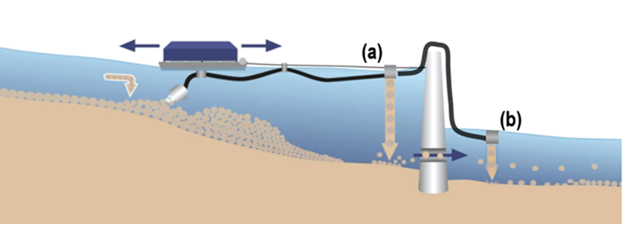SediMover® Technology (by D-Sediment and Hülskens Sediments)
Since dams are interrupting the natural sediment continuity and therefore the created reservoir suffers from sedimentation as well as the downstream river facing erosion, the obvious and only sustainable solution to overcome both problems is to re-establish a near-nature sediment transfer. Any other option would in the long run lead to either a silted and thus lost reservoir, massive dredging, dewatering and landfill, downstream river erosion or all combined, including the associated cost.
Major endeavor to achieve sustainability in reservoir management is to develop an environmentally friendly, reliable, and cost-effective solution which considers uninterrupted reservoir operation and associated use (e. g. power generation and recreation).
For ensuring this, D-Sediment and Hülskens Sediments developed the SediMover® technology and through this, were the winner of the BoR/USACE “Guardians of the reservoir challenge” with the judges being “impressed” on our achievements. Specialties of the patent protected equipment are:
1. Sediment is being continuously sucked in (similar to dredging) and being transferred to (a) the water intake/turbines or (b) directly downstream or (c, not displayed here) sediment treatment ashore.
2. The sediment mass transport can be adjusted to the downstream rivers transport capacity or other criteria. The sediment transfer is being continuously measured for environmental compliance, optimal equipment usage, and proper online documentation. By this, we re-establish a near-nature sediment continuity.
3. The vessels are designed for autonomous operation, allowing not only unmanned operation and thus cost efficiency, but also multiple effective operation time (virtually 24/7) compared to conventional dredging (8/5).
4. The equipment is scalable with single or multiple vessels, serving any reservoir size. It can be used solitary or in combination with land management/watershed protection, sluicing, sediment treatment or conventional techniques.
5. The SediMover® does not interfere with reservoir operation, not even during installation. It does not conflict with and preserves recreational functionality and navigation.
6. The SediMover®’s modular design allows for different collection technologies and working depths, pump capacities and types, alternative or parallel transfer options, easy equipment transport and installation, simple adaptation before and during operation, simplified on-site maintenance and spare part stocking

To put it to the point: Applying the SediMover® technology is a no-regret. The earlier you start, the more cost effective it will be. We already demonstrated the applicability in real-scale commercial projects. Exceeding this, we helped to establish public guidelines for application of the technology in cooperation with official stakeholders, including dimensioning and dealing with eventual sediment contamination.
Concerning Lewis & Clark Lake, we suggest to starting a pilot application close to the dam and then to extending range and capacity towards the delta front. By this, it is fitting perfectly into the so far discussed options at MSAC. By our technology we cannot only slow down the rate of sedimentation, but sustainably maintain the reservoir. We can do so only by this technology and in combination with other techniques.
And there is more to come: We are extending our technology to make use of “harvesting” methane emissions from sediment and are then performing practical climate protection, patent pending.
Further information is available at www.huelskens-sediments.com or in a video demonstration at https://youtu.be/5nqG4qT6e1w.
Additional points:
- One very important feature of the system is its ability to imitate a near-nature-sediment-transfer by data connection to the reservoir’s outflow information, considering the actual downstream river’s transfer capacity for sediment. By this, we prevent to overload the downstream river and at the same time allow an efficient and smooth sediment transfer and equipment utilization. A windfall profit is the data transparency of our system, allowing operators as well as authorities to monitor the system and the sediment transfer.
- In addition, the SediMover system has some more features, such as its ability to have it combined with classical dredging, if required. This is even increasing its utilization.
- Make use of the modular character of the system:
- Conduct a basic layout study
- Start with an initial (1) SediMover close to Gavins Point Dam
- Gain experience on the situation at Lewis and Clark Lake
Extend the operation step-by-step to reasonable scope (discharge and transfer distance), including operational and economic optimizations.
